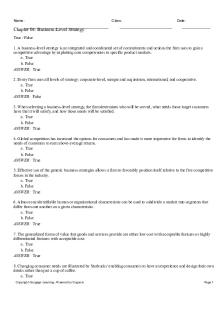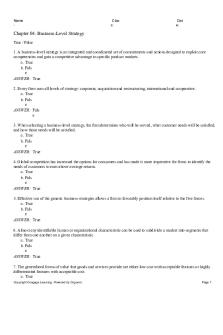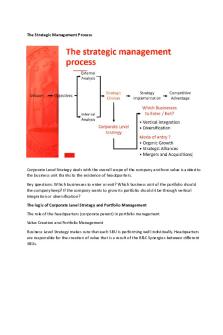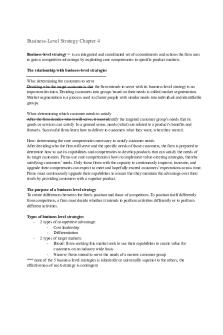Chapter 04 Business Level Strategy PDF

| Title | Chapter 04 Business Level Strategy |
|---|---|
| Author | Maryam Almutlaq |
| Course | strategic management |
| Institution | جامعة الشارقة |
| Pages | 21 |
| File Size | 215.8 KB |
| File Type | |
| Total Downloads | 33 |
| Total Views | 169 |
Summary
Download Chapter 04 Business Level Strategy PDF
Description
Name:
Class:
Date:
Chapter 04: Business-Level Strategy True / False 1. A business-level strategy is an integrated and coordinated set of commitments and actions the firm uses to gain a competitive advantage by exploiting core competencies in specific product markets. a. True b. False ANSWER: True 2. Every firm uses all levels of strategy: corporate-level, merger and acquisition, international, and cooperative. a. True b. False ANSWER: False 3. When selecting a business-level strategy, the firm determines who will be served, what needs those target customers have that it will satisfy, and how those needs will be satisfied. a. True b. False ANSWER: True 4. Global competition has increased the options for consumers and has made it more imperative for firms to identify the needs of customers to earn above-average returns. a. True b. False ANSWER: True 5. Effective use of the generic business strategies allows a firm to favorably position itself relative to the five competitive forces in the industry. a. True b. False ANSWER: True 6. Almost any identifiable human or organizational characteristic can be used to subdivide a market into segments that differ from one another on a given characteristic. a. True b. False ANSWER: True 7. The generalized forms of value that goods and services provide are either low cost with acceptable features or highly differentiated features with acceptable cost. a. True b. False ANSWER: True 8. Changing consumer needs are illustrated by Starbucks' enabling consumers to have an experience and design their own drinks rather than just a cup of coffee. a. True Copyright Cengage Learning. Powered by Cognero.
Page 1
Name:
Class:
Date:
Chapter 04: Business-Level Strategy b. False ANSWER: True 9. Companies without core competencies in their value-chain activities and support functions are still able to successfully implement either a cost leadership or a differentiation strategy, although they cannot implement an integrated cost leadership/differentiation strategy. a. True b. False ANSWER: False 10. To position itself differently from competitors, a firm must decide whether it intends to perform activities differently or to perform different activities. a. True b. False ANSWER: True 11. Southwest Airlines' tightly integrated activities make its cost leadership strategy more vulnerable to imitation than if its activities were loosely integrated. a. True b. False ANSWER: False 12. The key to Southwest Airlines' success has been its ability to continuously reduce costs while providing customers with superior levels of differentiation, such as an engaging culture. a. True b. False ANSWER: False 13. Strategic fit among the many activities in the value chain is critical for competitive advantage because it is more difficult for a competitor to match a configuration of integrated activities than to imitate a particular activity, such as sales promotion or a process technology. a. True b. False ANSWER: True 14. The difference between the cost leadership and differentiation business-level strategies on the one hand, and the focused cost leadership and focused differentiation strategies on the other, are their basis for customer value. a. True b. False ANSWER: False 15. A business model should be selected with great care because it cannot be changed, or even adjusted, once a firm begins to use the model to implement its business-level strategy. a. True b. False ANSWER: False Copyright Cengage Learning. Powered by Cognero.
Page 2
Name:
Class:
Date:
Chapter 04: Business-Level Strategy 16. A business-level strategy describes what a firm does to create, deliver, and capture value for its stakeholders. a. True b. False ANSWER: False 17. Cost leaders usually concentrate on the value-chain activities of inbound logistics and outbound logistics as a means to reduce costs. a. True b. False ANSWER: True 18. Firms implementing cost leadership strategies often sell no-frills standardized goods or services (but with competitive levels of differentiation) to the industry's most typical customers. a. True b. False ANSWER: True 19. A low-cost position in the industry is not a valuable defense against rivals when competing on the basis of price. a. True b. False ANSWER: False 20. A business-level strategy is a framework for how the firm will create value, while a business model creates the path a firm intends to follow to gain competitive advantage. a. True b. False ANSWER: False 21. Delgado is a U.S.-based firm that serves an international market. It determines product offerings and price points based on the country in which the product will be sold. Delgado is using consumption patterns as the basis for segmenting its customers. a. True b. False ANSWER: False 22. The value-creating activities associated with the cost leadership strategy and differentiation strategy are the same. a. True b. False ANSWER: False 23. Human resources and other support functions are not value-creating activities in the value chain; only value-chain activities create value. a. True b. False Copyright Cengage Learning. Powered by Cognero.
Page 3
Name:
Class:
Date:
Chapter 04: Business-Level Strategy ANSWER: False 24. In general, firms can be MOST effective if they develop business-level strategies that will serve the needs of the "typical customer" in the industry. a. True b. False ANSWER: False 25. The differentiation strategy is ineffective for products that are expensive, luxury consumer goods. It is best used for common, inexpensive products such as donuts. a. True b. False ANSWER: False 26. A risk of the differentiation strategy is that a firm's means of differentiation may cease to provide value for which customers are willing to pay. a. True b. False ANSWER: True 27. A business model is developed first. Then the firm takes steps to understand customers in terms of who, what, and how in order to develop a business-level strategy. a. True b. False ANSWER: False 28. The activities in the value chains of companies using focus strategies are quite different than the activities in the value chains of companies using industry-wide business strategies. a. True b. False ANSWER: False 29. A new generation of lunch trucks in cities such as New York, San Francisco, and Los Angeles is serving high-end fare such as hamburgers made from grass-fed cattle, escargot, and crème brulee, at less expensive prices than sit-down restaurants. This illustrates a focused differentiation strategy. a. True b. False ANSWER: True 30. A risk of a focus strategy is that the needs of customers within a narrow competitive segment may become more similar to those of industry-wide customers as a whole over time. a. True b. False ANSWER: True 31. Although it is a cost leader, IKEA also offers some differentiated features that appeal to its target customers, including Copyright Cengage Learning. Powered by Cognero.
Page 4
Name:
Class:
Date:
Chapter 04: Business-Level Strategy its unique furniture designs, in-store playrooms for children, wheelchairs for customer use, and extended hours. a. True b. False ANSWER: True 32. Flexible manufacturing systems, information networks, and total quality management are three techniques that make it possible for firms to implement the focused differentiation strategy. a. True b. False ANSWER: False 33. A flexible manufacturing system is a computer-controlled process used to produce a variety of products in moderate, flexible quantities with a minimum of manual intervention. a. True b. False ANSWER: True 34. Because of its focus on innovation and quality manufacturing, total quality management is not useful for firms that follow a cost leadership strategy. a. True b. False ANSWER: False 35. One of the benefits of the integrated cost leadership/differentiation strategy is that it is less risky than either the cost leadership or differentiation strategies. a. True b. False ANSWER: False 36. The hazard of getting "stuck in the middle" applies to firms using any business strategy. a. True b. False ANSWER: False 37. Steak and Shake just announced that it is selling some of its stores to individuals who will then pay a fee and royalties back to the company in exchange for use of the company name and products. Steak and Shake is transitioning into a franchise business model. a. True b. False ANSWER: True Multiple Choice 38. A business-level strategy is an integrated and coordinated set of commitments and actions the firm uses to gain a competitive advantage by exploiting core competencies in: a. the selection of industries in which the firm will Copyright Cengage Learning. Powered by Cognero.
Page 5
Name:
Class:
Date:
Chapter 04: Business-Level Strategy compete. b. specific product markets. c. primary value-chain activities. d. particular geographic locations. ANSWER: b 39. A firm's core strategy is its __________ strategy. a. corporate-level b. business-level c. pricing d. international ANSWER: b 40. When selecting a business-level strategy, the firm must determine all of the following EXCEPT: a. how the customers’ needs will be satisfied. b. who the customer is. c. what the customers' needs are. d. why these customers' needs should be satisfied. ANSWER: d 41. The three dimensions of a firm's relationships with customers include all the following EXCEPT: a. exclusiveness. b. affiliation. c. richness. d. reach. ANSWER: a 42. Which of the following statements is true? a. As customer loyalty increases, customers are more sensitive to price increases. b. Customer satisfaction has a positive relationship with firm profitability. c. Customer loyalty is fragile and cannot reliably be considered a factor in firm success. d. Customer loyalty is of importance only to firms using the differentiation strategy. ANSWER: b 43. The __________ dimension of relationships with customers is particularly important for social networking sites such as Facebook and Instagram. a. reach b. richness c. affiliation d. social ANSWER: a 44. Amazon has built capabilities around Internet technology and e-commerce to facilitate information exchanges with its Copyright Cengage Learning. Powered by Cognero.
Page 6
Name:
Class:
Date:
Chapter 04: Business-Level Strategy customers in a cost-effective manner. This represents which of the following service dimension? a. Reach b. Richness c. Affiliation d. None of the these is correct. ANSWER: b 45. Viewing the world through the customer's eyes and constantly seeking ways to create more value for the company enhances: a. the reach of the company toward the customer. b. the ability to identify the customer. c. the richness of the relationship with the customer. d. affiliation with the customer. ANSWER: d 46. Before a firm decides what products to offer and what benefits and features they will have, it must determine all of the following EXCEPT: a. who the firm should serve. b. when the customers' needs should be satisfied. c. what needs the firm should satisfy. d. how to use core competencies to satisfy customer needs. ANSWER: b 47. In the animal food products business, food-product needs of owners of companion animal pets (e.g., dogs and cats) differ from the needs for food and health-related products of those owning production animals (e.g., livestock). To which of the following aspects of managing customer relationships does this choice refer? a. Who: Determining the Customers to Serve b. What: Determining Which Customer Needs to Satisfy c. How: Determining Core Competencies Necessary to Satisfy Customer Needs d. When: Determining When to Satisfy Customer Needs ANSWER: a 48. Starbucks determined that all of the following customer needs were important EXCEPT: a. low price. b. the experience associated with drinking coffee, not just the coffee. c. the actual product of service (e.g., a cup of coffee), not the experience. d. allowing customers to design their own drinks. ANSWER: a 49. Hyundai allows customers to return their cars if they lose their job within 12 months of purchase. Hyundai is engaged in which of the following aspects of managing customer relationships? a. Who: Determining the Customers to Serve b. What: Determining Which Customer Needs to Satisfy c. How: Determining Core Competencies Necessary to Satisfy Customer Needs Copyright Cengage Learning. Powered by Cognero.
Page 7
Name:
Class:
Date:
Chapter 04: Business-Level Strategy d. When: Determining When to Satisfy Customer Needs ANSWER: b 50. An interior decorator has moved his business from Los Angeles to St. Paul, Minnesota because his spouse's company transferred her to St. Paul. The decorator is distressed because the customers in his target market have, in his words, "banal and bourgeois taste." Which of the following is the decorator's problem? a. The decorator does not understand that customer needs are neither right nor wrong, and neither good nor bad. b. The decorator has no core competencies that will transfer to his new geographic market. c. The decorator has not been able to choose a strategy of cost leadership in this environment. d. The decorator is highly affiliated with the new target market and understands how he can create value for it. ANSWER: a 51. In order to meet and exceed customers' expectations over time, firms must: a. constantly manipulate customers' perceptions of their needs. b. answer the questions: who, what, when, where, how, and why as they apply to customers. c. continuously improve, innovate, and upgrade their core competencies. d. successfully defend their established core competencies from imitation by competitors. ANSWER: c 52. Business-level strategies are concerned specifically with: a. creating differences between the firm's position and its competitors. b. selecting the industries in which the firm will compete. c. how functional areas will be organized within the firm. d. how a business with multiple physical locations will operate one of those locations. ANSWER: a 53. An entrepreneur is investigating starting a company that provides tax advice to small companies. In order to position his company differently from the existing competitors, the entrepreneur must: a. analyze the reach, richness, and affiliation the company must have with its customers. b. provide tax advice either in a different manner or provide a different kind of tax service than competitors. c. offer tax advice at a price lower than the cheapest competitor. d. offer tax advice at a higher quality than the best competitor. ANSWER: b 54. Which of the following are central to implementing value-creating strategies and thereby satisfying customers' needs? a. Firm resources b. Capabilities c. Core competencies d. None of these is correct. ANSWER: c 55. An analysis of the activity map of a successful company such as Southwest Airlines emphasizes how: a. the organizational culture of Southwest Airlines is the key to its success. Copyright Cengage Learning. Powered by Cognero.
Page 8
Name:
Class:
Date:
Chapter 04: Business-Level Strategy b. understanding the profitability in an industry indicates to companies where above-average returns can be earned. c. it is harder for rivals to match a configuration of integrated activities than to imitate a single activity. d. the primary and support activities of a successful company capture value all along the value chain. ANSWER: c 56. By examining the activity map of Southwest Airlines, one can identify the areas of __________ around which it has developed its business strategy. These themes include limited passenger service, high aircraft utilization, and highly productive ground and gate crews. a. strategic intent b. core competency c. differentiation d. data analytics ANSWER: a 57. If Southwest Airlines’ employees lost their high enthusiasm and commitment to the company: a. the airline could continue without problems because its cost leadership strategy is dependent on its efficient internal procedures. b. replacement employees could be hired from rival airlines that are laying off employees and easily be merged into the Southwest culture. c. there would be no impact on Southwest's profitability because Southwest's customers value the low fares rather than being "entertained" by the employees. d. Southwest would have lost one of its competitive advantages, and its performance would be threatened. ANSWER: d 58. Strategic fit among many activities (often illustrated in an activity map) is fundamental to: a. the development of core competencies for a firm. b. the breadth of competitive scope for a firm. c. sustainability of a firm's competitive advantage. d. the integrity of the firm's value chain. ANSWER: c 59. All of the following are considered generic business-level strategies EXCEPT: a. product diversification. b. cost leadership. c. focused differentiation. d. integrated cost leadership/differentiation. ANSWER: a 60. A company using a narrow target market in its business strategy is: a. following a cost leadership business strategy. b. focusing on a broad array of geographic markets. c. limiting the group of customer segments served. d. decreasing the number of activities on its value chain. Copyright Cengage Learning. Powered by Cognero.
Page 9
Name:
Class:
Date:
Chapter 04: Business-Level Strategy ANSWER: c 61. As the television industry has changed in the last few decades from just three major networks to a multiplicity of networks, one of the major aspects of business strategy for the newer networks is a(n) __________ than the traditional networks. a. broader target market b. narrower target market c. increased use of primary activities to capture value d. increased use of support activities to capture value ANSWER: b 62. The effectiveness of any of the generic business-level strategies is contingent on both: a. customer needs and competitors' strategies. b. the opportunities and threats in a firm’s external environment and the strengths and weaknesses derived from the firm’s resource portfolio. c. the trends in the general consumer base and the robustness of the global and industry economy. d. the firm's competitive scope and its competitive advantage. ANSWER: b 63. How does a firm capture value when using a franchise business model? a. By receiving fees and royalty payments b. By selling a premium version of its product or service c. By giving advertisers access to target customers d. By matching those who want a service with those who are providing it ANSWER: a 64. A cost leadership strategy targets the industry's __________ customers. a. most typical b. poorest c. least educated d. most frugal ANSWER: a 65. Durable Ceramics, Inc., provides inexpensive ceramic tile to builders of institutional buildings such as schools, prisons, and public administration buildings. It has always competed on a cost leadership basis. Most of its products are purchased by a few commercial construction firms, so it is fairly dependent on these construction firms for selling its product. Durable Ceramics' next-most-efficient competitor, Cost-Less Ceramics, Inc., earns average returns, whereas Durable earns above-average returns. The commercial construction firms are putting pressure on Durable to reduce its prices. If Durable reduces its prices below those of Cost-Less's prices, it is likely that: a. both Durable and Cost-Less will devise additional ways to become more efficient in their production processes. b. Durable will be unable to absorb the lower cost and will go out of business. c. both Cost-Less and Durable will go out of business, leaving the customers with fewer alternative sources of Copyright Cengage Learning. Powered by Cognero.
Page 10
Name:
Class:
Date:
Chapter 04: Business-Level Strategy low-cost tile. d. Cost-Less will go out of business, and Durable will gain higher power over its customers. ANSWER: d 66. ...
Similar Free PDFs

Chapter 04 Business Level Strategy
- 21 Pages

Chapter 04 Business Level Strategy
- 25 Pages

3 - Business level strategy
- 3 Pages

Business Level strategy
- 14 Pages

Business level strategy Samsung
- 5 Pages

CH 4 - Business Level Strategy
- 9 Pages

Chapter 6 - Corporate-Level Strategy
- 10 Pages

3. Corporate Level Strategy
- 18 Pages

Business Strategy
- 60 Pages
Popular Institutions
- Tinajero National High School - Annex
- Politeknik Caltex Riau
- Yokohama City University
- SGT University
- University of Al-Qadisiyah
- Divine Word College of Vigan
- Techniek College Rotterdam
- Universidade de Santiago
- Universiti Teknologi MARA Cawangan Johor Kampus Pasir Gudang
- Poltekkes Kemenkes Yogyakarta
- Baguio City National High School
- Colegio san marcos
- preparatoria uno
- Centro de Bachillerato Tecnológico Industrial y de Servicios No. 107
- Dalian Maritime University
- Quang Trung Secondary School
- Colegio Tecnológico en Informática
- Corporación Regional de Educación Superior
- Grupo CEDVA
- Dar Al Uloom University
- Centro de Estudios Preuniversitarios de la Universidad Nacional de Ingeniería
- 上智大学
- Aakash International School, Nuna Majara
- San Felipe Neri Catholic School
- Kang Chiao International School - New Taipei City
- Misamis Occidental National High School
- Institución Educativa Escuela Normal Juan Ladrilleros
- Kolehiyo ng Pantukan
- Batanes State College
- Instituto Continental
- Sekolah Menengah Kejuruan Kesehatan Kaltara (Tarakan)
- Colegio de La Inmaculada Concepcion - Cebu






